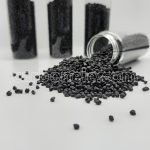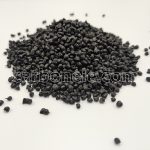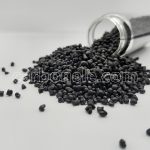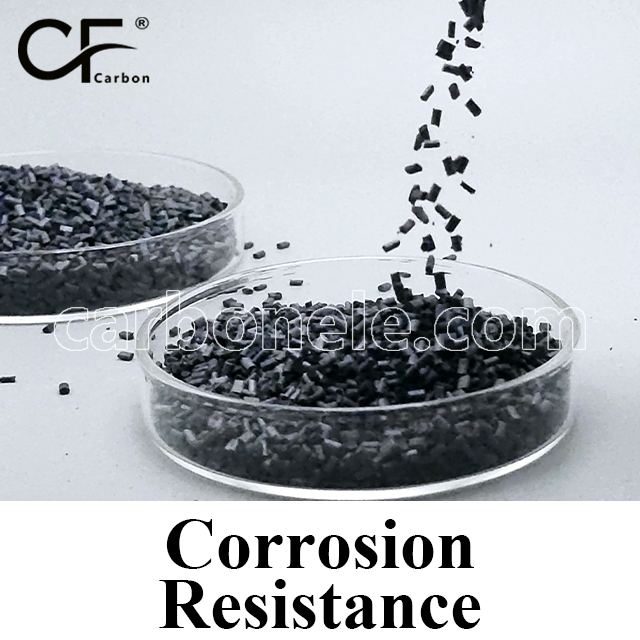
PPA CF40 40% Carbon Fiber PPA Vendors
PPA Carbon Fiber 40% composites combine Polyphthalamide (PPA) with 40% carbon fibers, offering high strength, stiffness, and heat resistance. Ideal for automotive, aerospace, and industrial applications requiring lightweight, durable materials with excellent mechanical properties and chemical resistance.
- Model number: PPA-CF-BCA4
- Filler: Carbon fibers, additives, etc.
- OEM: Yes
- Color: Black
- Free samples: 1-10kgs
- MOQ: Negotiable
What’re PPA 40% Carbon Fiber composites?
PPA (Polyphthalamide) Carbon Fiber composites refer to a type of material where Polyphthalamide, a high-performance engineering thermoplastic, is reinforced with carbon fibers. Here are some key points about PPA CF40 composites:
Material Composition: These composites typically consist of 40% by weight of carbon fibers embedded in a PPA matrix. The carbon fibers provide strength, stiffness, and durability, while PPA offers excellent mechanical properties and resistance to heat and chemicals.
Why to Choose PPA CF40% Composites?
– Strength: Carbon fibers are known for their high tensile strength, making the composite suitable for applications requiring structural integrity and load-bearing capabilities.
– Stiffness: The addition of carbon fibers enhances the stiffness of the material, enabling it to maintain its shape under load.
– Lightweight: Despite its strength, carbon fiber composites are relatively lightweight, which is advantageous in weight-sensitive applications.
– Temperature Resistance: PPA as a matrix material provides good thermal stability, allowing the composite to withstand high temperatures without significant degradation.
What Advantages does PPA 30% CF has compared to other materials?
PPA CF40 composites are typically processed using techniques such as compression molding, injection molding, or resin transfer molding, depending on the specific application requirements and desired final properties.
– Enhanced mechanical properties compared to non-reinforced PPA.
– Reduced weight compared to metals with similar strength characteristics.
– Resistance to corrosion and chemicals, suitable for harsh environments.
Where are Application Fields of PPA 40%CF?
PPA CF40 finds extensive application in industries requiring lightweight yet robust materials with high mechanical strength and thermal stability. Key fields include automotive (for structural components), aerospace (for lightweight parts), and industrial sectors (for machinery components and tooling). These composites excel in environments demanding superior performance under stress, heat, and chemical exposure.
– Automotive: Used in structural components where high strength-to-weight ratio and durability are crucial.
– Aerospace: Components requiring lightweight materials with excellent mechanical properties.
– Industrial: Machinery parts, tooling, and other applications where high performance under demanding conditions is required.
An Application Case
In the field of smart household appliances, PPA CF40 plays an important role. Take the smart sweeping robot as an example, which has extremely high requirements for the performance of materials.
PPA CF40 has excellent high-temperature resistance and chemical corrosion resistance. When the smart sweeping robot is working, the motor part will generate high heat, and the PPA 40%CF produced by Carbon (Xiamen) New Material can maintain stable performance in such a high-temperature environment to ensure the normal operation of the machine. At the same time, there may be various chemical substances such as cleaners in the household environment, and the chemical corrosion resistance of PPA 40% Carbon Fiber can prevent it from being eroded by these substances.
After long-term use, the smart sweeping robot with key components made of PPA CF 40, even in the hot summer and frequent contact with cleaners, these components have not shown problems such as deformation, damage or performance degradation. Moreover, the high-strength characteristic of PPA + CF40 also makes the structure of the robot more stable, reducing the faults caused by collision or vibration. This not only extends the service life of the smart sweeping robot, but also provides users with more reliable and efficient cleaning services, making home cleaning more relaxed and convenient.
Should you have any interest in PPA CF40 or other carbon fiber reinforced composites, please feel free to contact us. Please click here to watch more videos on CFRTPs.
What's PPA (Polyphthalamide)?
PPA (Polyphthalamide) is a kind of thermoplastic functional nylon. It is prepared by polycondensation of phthalic acid and phthalic diamine, and can also be formed by polycondensation of aliphatic diamine or diacid with benzenoid diacid or diamine. Main Features as below: Excellent strength, toughness and hardness Good heat resistance Excellent chemical resistance Crack resistance ability Low water absorption Better dimensional stability Good surface glossiness Good processability

Frequently Asked Questions
Carbon (Xiamen) New Material Co., Ltd. aims to provide buyers with "one-stop" worry-free high-quality services. Here you can find all information about carbon fiber engineering plastics. If you still have questions, please send us an email for consultation!
-
How can I contact the manufacturer of a product that interests me?
When you find a product you are interested in, you can contact the manufacturer directly by sending an email and we will get back to you as soon as possible.
-
How do I find the products that interest me?
All you need to do is enter the keyword, product name in the search window and press the Enter key on your keyboard. Your search results page will then be displayed. You can also search within the product category pages on the home page. Each category is divided into subcategories, allowing you to refine your search and find products that interest you.
-
Where will I find a buying guide?
Please contact our after-sales service directly and we will provide you with a comprehensive operating guide.
-
What are CF Reinforced Thermoplastic Composites?
CF Reinforced Thermoplastic Composites are materials where carbon fibers are incorporated into a thermoplastic matrix. They combine the strength and stiffness of carbon fibers with the processability and recyclability of thermoplastics. For instance, they are used in automotive parts like bumper beams.
-
What are the benefits of CF Reinforced Thermoplastic Composites over traditional composites?
The key benefits include faster production cycles, easier recyclability, and better impact resistance. They also offer design flexibility. An example is in the manufacturing of consumer electronics casings where complex shapes can be achieved more easily.
-
How are CF Reinforced Thermoplastic Composites processed?
Common processing methods include injection molding, extrusion, and compression molding. Injection molding is widely used for mass production. For example, in the production of small components for the medical industry.
-
What industries use CF Reinforced Thermoplastic Composites?
They are utilized in aerospace, automotive, medical, and sports equipment industries. In aerospace, they can be found in interior components. In the medical field, they might be used in prosthetics.
-
How does the carbon fiber content affect the properties of the composites?
Higher carbon fiber content generally leads to increased strength and stiffness but may reduce ductility. A moderate content is often balanced for specific applications. For example, a higher content might be preferred in structural parts of a race car.
-
What are the challenges in using CF Reinforced Thermoplastic Composites?
Challenges include higher material costs, complex processing equipment requirements, and ensuring uniform fiber dispersion. Issues with adhesion between the fibers and the matrix can also arise. An example is in achieving consistent quality in large-scale production.


























